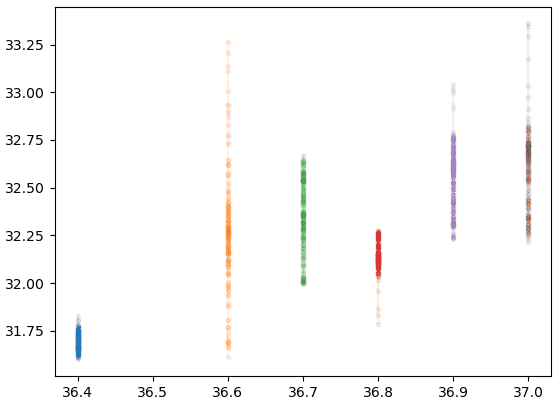
Table of Contents
22MILES Thermal Sensing FAQ
 FAQ 22MILES Thermal Sensing FAQ Rev 3.1, 05/11/2020
FAQ 22MILES Thermal Sensing FAQ Rev 3.1, 05/11/2020
What’s Thermal Sensing?
Thermal Sensing leverages a thermometer that measures temperature or a temperature gradient. A thermometer has a temperature sensor in which some change occurs with a change in temperature and converts this change into a numerical value.
What’s an Infrared Thermometer
An infrared thermometer is a non-contact thermometer that infers temperature from a portion of the thermal radiation, sometimes called black-body radiation emitted by the object being measured. By knowing the amount of infrared emitted by the item and its emissivity, the object’s temperature can often be determined within a specific range of its actual temperature. Infrared thermometers are a subset of devices known as “thermal radiation thermometers.”
Sometimes, especially near ambient temperatures, readings may be subject to error due to the reflection of radiation from a hotter body—even the person holding the instrument— rather than radiated by the object being measured, and to an incorrectly assumed emissivity.
What are we testing?
We are testing the skin temperature, not the fever inside the body. Please also note when visitors walk into a building from cold weather, their skin is below their body temperature, while it could be much higher if visitors just suntanned on the beach.
What are the technologies and difference?
There are mainly two types of infrared thermometer sensors available: thermopile and thermal cam.
Thermopile is an economical solution. It’s been used widely for forehead temperature guns for close distance testing. The thermopile sensor is sensitive to distance and typically requires short distance, like 1.5ft, for testing. This distance sometime could be too tight for public area use. Another limitation is that the sensor tests a tiny fraction of skin as it works like a laser beam – visitors cannot wear a hat or have to adjust their standing height to fit the face mask on the screen. The main benefit is a lower cost of the sensor, one fifth to one-tenth of a primary Thermal Cam sensor.
Thermal cam is a higher-end solution and usually support 5,000 testing points at a time, this equals to roughly 6ft-12ft wide area within 15ft. The higher resolutions, the larger sizes can be tested.
What sensors does 22M support?
22M doesn’t manufacture any thermal sensor. We aim to support as many brands of sensors as possible to help minimize global supply chain issues.
22M, after numerous research, by default ships FLIR sensors. FLIR Systems is the world’s largest commercial company specializing in the design and production of thermal imaging cameras, components, and imaging sensors. FLIR, based in Wilsonville, Oregon, is a component of the S&P 500 index with annual revenues in excess of $1.5 billion annually as of 2014.
22M also has finished support sensors from a few other vendors.
What’s the value of 22M Thermo Sensing Systems?
The first topic ever about Thermo Sensing is: what’s the accuracy. FLIR’s most sensors, from FLIR ONE to E95, has the same accuracy level at ±2°C (±3.6°F) for ambient temperature 15°C to 35°C (59°F to 95°F). That means 38°C (100.4°F) with ±2°C (±3.6°F) would cove most common body temperature, and we need something better. 22M team works on Machine Learning algorithms to train the system for calibration and reduce drifting.
22M, with 12-year digital signage and interactive software experience for all industries, has also developed several applications tailored for the US market. 22M has DoD and other security certifications to guarantee particular data has been well taken care of per each customer’s unique requirements.
Figure 1. Raw logs of our lab monitoring of black-body source in different temperature
What’s the accuracy?
The accuracy depends on each sensor supported. As well as, How many training parameters have been taken into consideration in the delivery package. Without room temperature and humidity accessory, FLIR sensor can be ±0.3°C (±5.5°F) at 20°C (68°F) and 40% RH at 4ft distance. If your facility has a very different ambient environment, please let us know, and we will work on a unique training environment for you.
In a multi-user tracking scenario, we would recommend including a black-body source (temperature reference).
Can 22M further improve the accuracy?
Yes, 22M is working on delivering room temperature and humidity sensors. Once available, this would be added to the default delivery package. Existing customers can request an addon at a small cost.
Does 22M provide Calibration Feature in the software?
Yes, 22M provides a manual calibration interface in the software.
What’s the average body temperature?
Most people think an average body temperature is an oral temperature (by mouth) of 37°C (98.6°F). This is an average of normal body temperatures. Your normal temperature may be 0.6°C (1°F) or more above or below this. A forehead (temporal) scanner is usually 0.3°C (0.54°F) to 0.6°C(1.1°F) lower than an oral temperature.
Does 22M provide an option to adjust the temperature threshold in the software?
Yes, the system sets to 37.5°C (99.5°F) to ring the alarm. We do provide an interface to change this value to what you desire.
What is included?
22M has a core package of Thermo Cam + Software for any Windows Systems. Clients or partners have the option to purchase their kiosks, tablets, or all-in-one PCs or through 22M. 22M has a few hardware partners with verified systems that we recommend for this purpose. Android support will be ready soon.
Does the system have FCC?
Yes, all hardware parts/components used in the 22M default shipment has FCC.
Is the system FDA approved?
No. The device is for preliminary skin temperature screening but not for medical use. Please refer to the following link for details. https://www.fda.gov/medical-devices/classify-your-medical-device/how-determine-if-your-product-medical-device
[contact-form to=”[email protected],[email protected]” subject=”22Miles FAQ”][contact-field label=”Name” type=”name” required=”1″][contact-field label=”Email” type=”email” required=”1″][contact-field label=”Telephone” type=”text”][contact-field label=”Message” type=”textarea”][/contact-form]

